
RAINFORD CHURCH OF ENGLAND SCHOOL
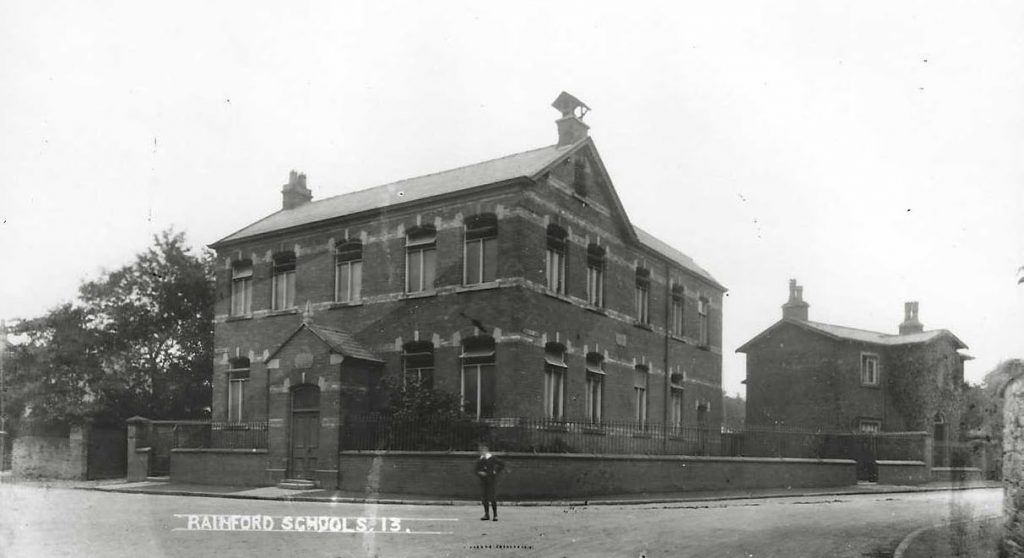
CHURCH OF ENGLAND SCHOOL c 1910
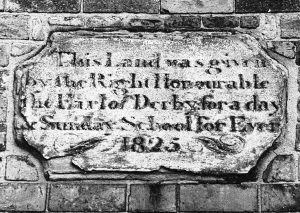
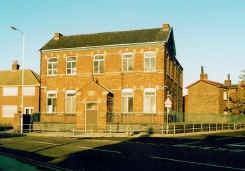
CHURCH OF ENGLAND SCHOOL
THE VILLAGE SCHOOL
When the Puritan minister Adam Martindale penned his life story he tells of attending the school at Rainford in the 1630’s. This school belonged to the township and was under the control of school wardens appointed annually at the Manor Court. It was in due course succeeded by the old Grammar School in 1668.
In 1825 the minister of Rainford Chapel reported to the Bishop of Chester that there were three schools in the village none of which belonged to the Chapel authorities. To rectify this situation the Chapel Warden, Stephen John Langhorne, requested the Earl of Derby to provide a piece of land on which to facilitate the establishment of a Sunday School to be conducted under the eye of Reverend Mr Ellam, minister of Rainford Chapel. The Earl met this request and gave the site on the corner of Ormskirk Road and Cross Pit Lane. Nothing passed in writing at this time but the plaque above the door of the existing building tells that…..
This Land was given
by the Right Honourable
the Earl of Derby for a day
or Sunday School for Ever
1825
The Chapel authorities were however unable to raise the money needed to erect a school on the site and at some time later Mr Henry Birchall, a butcher, paid the whole cost of building a school. He did this in order to provide for his crippled son Joseph who became the first school master there. Henry stipulated that he was to have the entire use of the building during week days and allowing the Chapel to use it on Sundays on paying an annual rent. This situation lasted for some years until a quarrel broke out and Birchall left the Chapel and joined the Dissenters or Independents on Higher Lane refusing Mr Ellam the use of the school on Sundays.
From this time Mr Ellam’s children were taught in the Chapel itself whilst the children of the Dissenting minister, Mr Widdows, had the school exclusively on Sundays. Legal advice was sought and eventually Birchall was evicted and the situation was finally resolved in 1843 when the Earl of Derby executed a proper conveyance of the land to seven trustees under the management and control of the Minister of the Chapelry of Rainford. The school, then known as the National School, was now firmly in the hands of the Chapel.
In 1850 the Committee of Council on Education, upon application by the trustees, granted a sum of money towards the fitting up of the school to make it fit for a day school and also towards the expense of building a house for the teacher or teachers of the day school. In the same year the Earl gave an adjoining piece of land for a teacher’s house and a playground.
In January 1877 the school building was demolished and a new two storey school built upon the site due largely to the generosity of Mr Richard Pennington of Muncaster Hall. During the rebuilding the pupils continued their classes in rooms at the Eagle & Child, the Golden Lion and the Derby Arms. On the 16th of July 1877 the new school was opened with a new arrangement of accommodation and new rules and regulations.
This new building had virtually covered the playground given by the Earl but it was not until 1927 that the field between the school and the railway was obtained from Mrs Richardson of neighbouring Rainford House for use as a school playground.
This building served several more generations of Rainford scholars before it was finally closed on 19th July 1990. All the remaining staff and pupils were then transferred for the start of the next school year to the new Cross Pit Lane C of E School which had been built further up the lane.
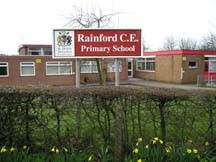
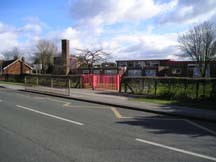
BUSHEY LANE SCHOOL
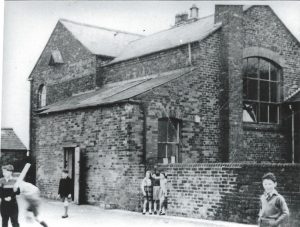
BUSHEY LANE SCHOOL
Buildings retained from the first commercial colliery in Rainford later became a school at Bushey Lane. Known as Rainford Coal Company School (Limited) and known more locally as ‘No 8’ it opened for boys, girls and infants on Monday 13th August 1877. Accompanied by their parents, seventy four children, were admitted and were addressed by Rev. Samuel Marle.
Cleaning of the school was undertaken by Mrs N. Holme who was also appointed sewing teacher.
Mr George Steinly, Certified Teacher, was appointed in April 1878 and the school continued under various Head Masters and Mistresses until finally closing its doors 113 years later on the 19th July 1990. Fittingly, Mr Ron Cordingley, grandson of Mr. Steinly attended the final closure. The children were then amalgamated into Rainford C. of E. School in Cross Pit Lane.
CORPUS CHRISTI SCHOOL
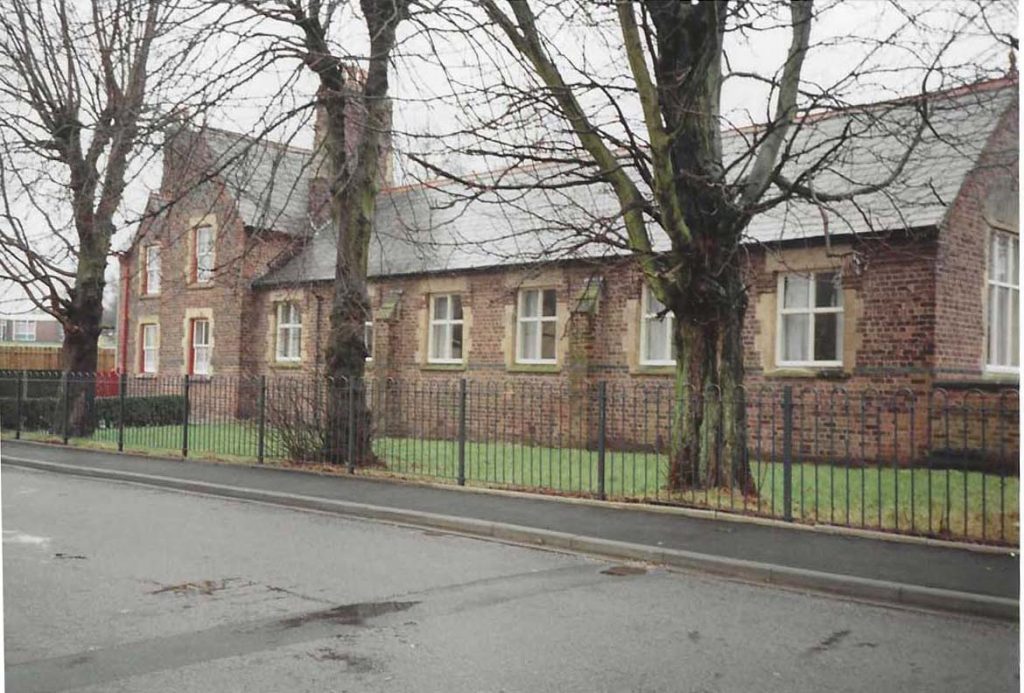
THE OLD SCHOOL BUILT IN 1874
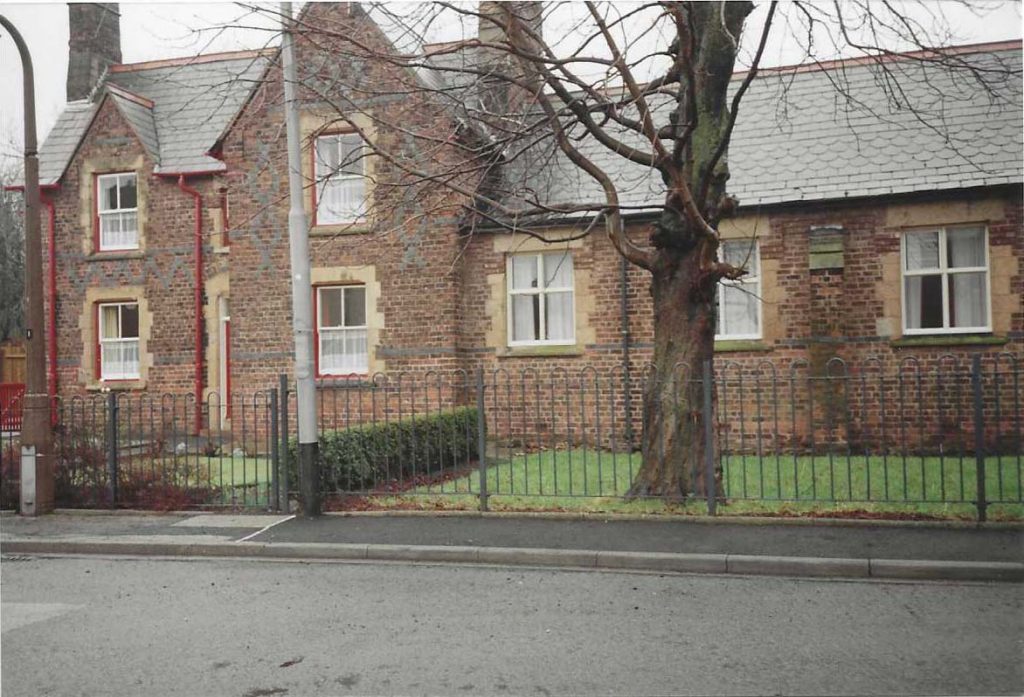
THE SCHOOL HOUSE
CORPUS CHRISTI SCHOOL
Long before 1874 the Roman Catholic Community had tried many times to acquire land for the purpose of building a school and church. When the Rev. Father Austin Powell, Catholic priest of St Mary’s Church, Birchley, finally purchased land at auction, via Thomas Mather of Billinge, his first concern was to provide education facilities for the children of Rainford. At a cost of £1,050 including fittings, the school designed to accommodate 135 pupils was built by Mr. John Middlehurst. Following the laying of the first stone a few months earlier, the opening of the school took place on the evening of Monday 10th August,1874, and was celebrated by a tea-party and concert. The following day 80 children attended school under the tuition of Miss Coleman who had been provided with living accommodation in the adjoining School House. So encouraged was Father Powell by his success upon seeing the school completed, he quickly continued with his preparations to build a new Catholic Church on the remainder of the land adjoining the school. This was completed the following year. The old school building still stands today, and is currently used as a Hall for the New Church which is situated close by.
By the 1960’s it was becoming increasingly evident that the Old School was no longer large enough to accommodate all the children from the growing local catholic community, so this new school was built on nearby land.
THE NEW SCHOOL OPENED IN 1967
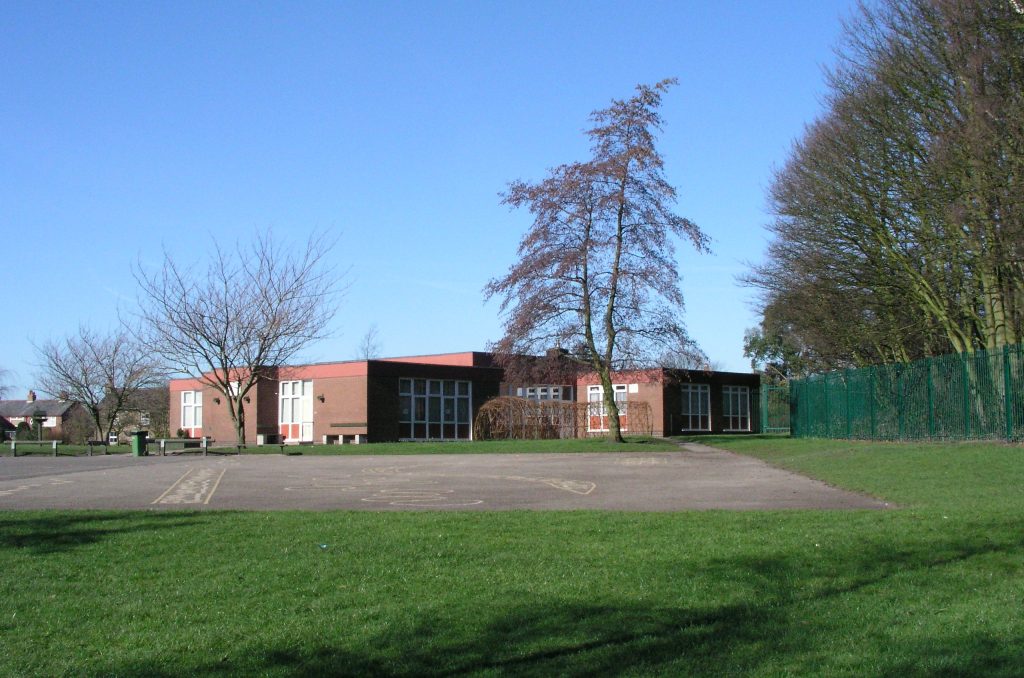
NEW SCHOOL ENTRANCE
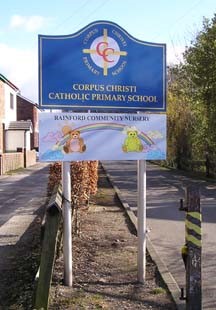
BROOK LODGE SCHOOL
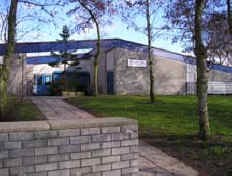
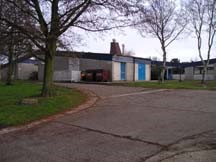
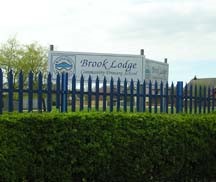
BROOK LODGE SCHOOL
Opened in 1972, this school was the first of a modern interior design, known as ‘open plan’ With the village population growing, Lancashire County Council considered it necessary to provide another primary school. This was the last school to be built by L.C.C. before Rainford became part of St. Helens Borough Council.
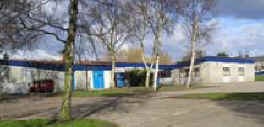
RAINFORD HIGH SCHOOL
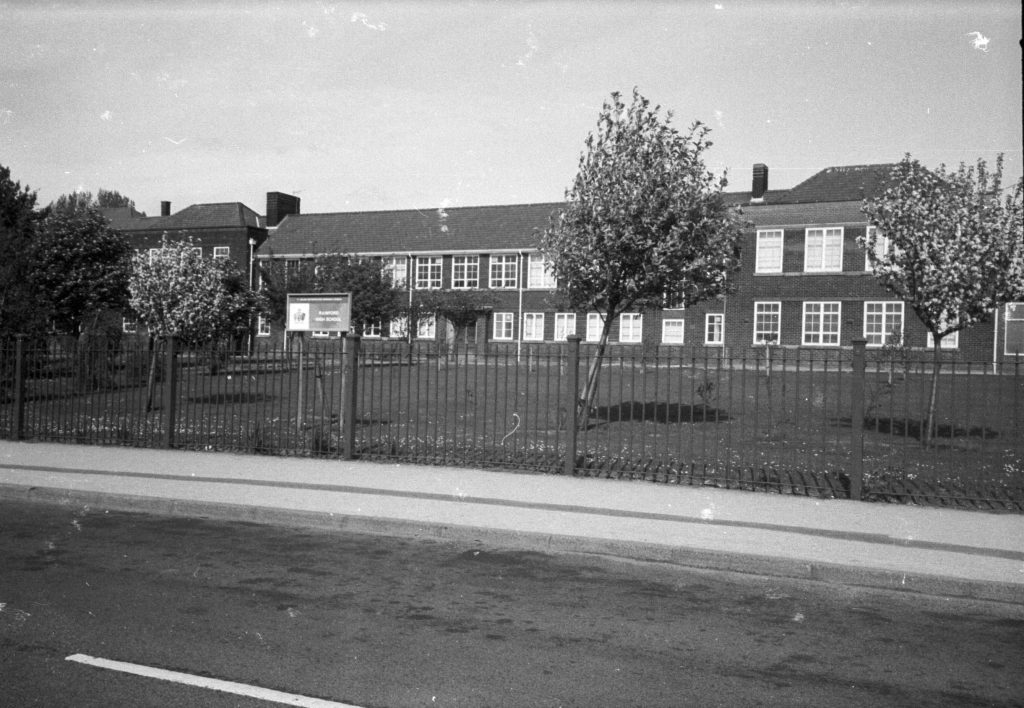
Opened on the 7th August 1940 this school was originally known as Rainford Senior Council School and was part of Lancashire Division 16. Mr Frank Lees was the first headmaster and along with 3 other teachers taught 127 pupils.
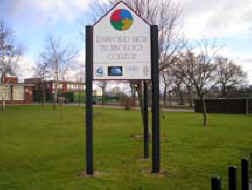
In those early days lessons were often disrupted by air raids and pupils had to go into the shelters and wait for the all clear. There was an official opening ceremony held on 10th October 1940 attended by Lord Derby. For two weeks in 1941 the school was used as an overnight rest centre for evacuees from Liverpool escaping the German bombing. In 1945 the school changed its name to Rainford County Secondary School. At this time pupils only had 3 weeks summer holiday but had two weeks in October to help with the potato harvest. Pupils at this time left school at the age of fourteen. This was raised to fifteen in 1947 and again to sixteen in 1973.
During the 40’s and 50’s the school grew and by the late 50’s a Commercial course and a Technical course were established and pupils could stay on into a fifth year to take external examinations. In 1960 the first few pupils sat O level examinations.
In 1961 Mr David Hay took over as headmaster and continued the school development with the first pupils sitting GCE A levels in 1962. Only two other schools in Lancashire offered A levels at this time. The school had secondary modern status until 1971 when it became a comprehensive school and changed its name to Rainford High School. An arson attack in 1972 caused a major fire destroying the music room and causing considerable damage to the arts theatre and surrounding classrooms which then delayed the start of the academic year.
In 1977 the sports hall was built and with the extension of the playing fields allowed greater range of sports to be played at the school.
In 1987 Mr Shapcott became the new headmaster and abolished the streamed system of classes based on Maths and English tests taken by pupils in their first week. By 2001 the school had achieved Technology College and Beacon School status and changed its name to Rainford High Technology College.
A major rebuild of the school, changing the front appearance of the school was completed in 2013 under the Building Schools for the Future programme and in 2017 Academy status was granted. It was at this time the school reverted to its previous name of Rainford High School. Further expansion of the buildings was completed in September 2021.
Notable pupils attending the school over its history have included Willy Russell the writer and Andrew Harrison who went on to become the CEO of Carphone Warehouse.
ROSBOTHAM’S SCHOOL
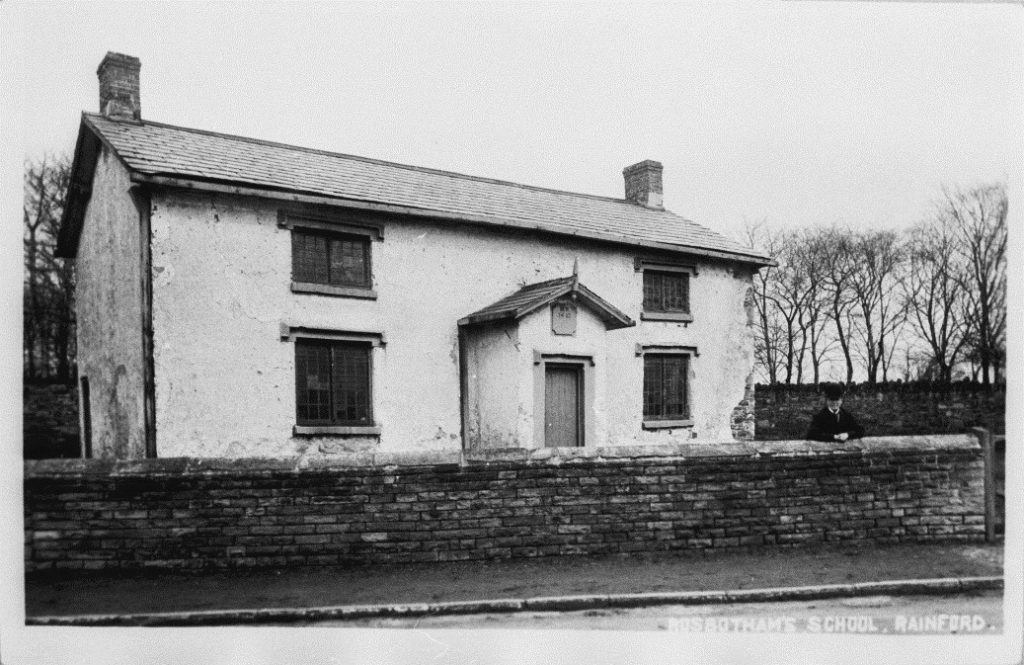
ROSBOTHAM’S SCHOOL ALONG HIGHER LANE.
In 1847 Daniel Rosbotham, a shoemaker, gifted a plot of land on Higher Lane and materials to build a Day and Sunday School for the Congregational Church. When he died in 1858 he left sufficient money to build a boundary wall around the Sunday School.
By 1912 the old Sunday School had reached its demise and been replaced with a much larger one. In 1976 a new church hall and Sunday School were built nearer to the United Reformed Church and this plot was sold for private house building.
THE IMAGE HOUSE SCHOOL
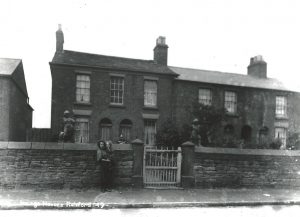
THE IMAGE HOUSE
The Image House, with its two large stone statues standing in the front garden, has mystified visitors and locals alike for many years. The origin of these two figures has been the subject of many myths and theories handed down from previous generations but none with any substantiating evidence. The house, which originally stood alone, has been converted into two dwellings each with a statue in its garden. These statues are now Grade II listed monuments described in the listing as “Probably 19th century but may be earlier. Cast artificial stone or terracotta. A pair of statues in Roman type costume, the one on the left perhaps Perseus with the head of Medusa or perhaps Minerva who had Medusa’s head on her shield as here; the one on the right apparently Mars”.
The house originally formed part of the large estate of John Bispham and existed as far back as 1744. John Bispham, born in 1698, was a yeoman farmer occupying what is now known as White House Farm. He was a trustee for the Independent Chapel on Higher Lane and also the son-in-law of the minister, the Reverend Renald Tetlaw, who. in his will of 1744 bequeathed a selection of books from his extensive library “To be kept in one of John Bispham’s houses as heirlooms to the house from Generation to Generation” This indicates that at that time John had other houses in addition to White House Farm.
On the death of John Bispham in 1784 the freehold of the estate passed to his eldest son William who was a woollen draper of Prescot and on his death in 1807 to his son Thomas, a gentleman of Roby. Neither William nor Thomas actually occupied the farm or houses which were leased to Edward & Ann Pye and then to their son William and his wife Ann.
In 1826 Toyn Parkin, a school teacher from Manchester, was married at Rainford Chapel to Esther Atherton. Esther was the daughter of William Atherton who was the schoolmaster at the Grammar School in Rookery Lane where Toyn Parkin assisted as a teacher. Toyn & Esther took up residence in the vacant Image House in 1830 and an entry in the next Land Tax Assessment has the word “Images” along side his name. This is the earliest known mention of the word Image in connection with this house. Was Toyn responsible for the erection of the statues ? Two years later they had established a boarding school for boys and were advertising this in local newspapers. From 1849 it was named in similar advertisements as “The Image House Academy”.
Liverpool Mercury 27 July 1832
BOARD AND EDUCATION
Image House, Rainford, near Prescot
- PARKIN takes a limited number of Pupils and educates them in Commercial and Mathematical Learning on the following terms :-
Young Gentlemen under Ten Years of Age, 18 Guineas per annum; above Ten Years and under Fifteen, 20 ditto: above Fifteen Years, 24 ditto.
The course of Education comprises English Grammatically, and Composition; Geography, and the use of Globes; Writing, Arithmetic, and Merchants’ Accompts, Mensuration, Land Surveying, Gauging, Trigonometry, Navigation, Algebra.
No charge for Entrance; nor any extras; but three months notice or pay previous to the removal of a Pupil.
Vacations three weeks at Christmas, and a fortnight at Midsummer.
Toyn Parkin died just before the Census of 1841 was taken and his widow Esther was then described as being Mistress of the Boarding School. Also in the house were Benjamin Bennett a twenty year old teacher from Sheffield, two female servants and eighteen boys between the ages of seven and fifteen. By 1851 Esther Parkin had left the village and the teacher Benjamin Bennett and his wife Elizabeth were occupying the Image House with two servants, one teacher and fifteen boarding scholars from nearby towns and cities. The school had dwindled to two boarders by 1861 and, although he may have been taking day-boys, the end of this Academy was in sight. It was certainly discontinued by 1871, the Bennetts had departed to West Derby and the house has been a private residence ever since.
Thomas Bispham of Roby, the owner of the house, died in 1840 leaving the whole of his estate to his two daughters Amelia Kay and Margaretta Bispham. On the twelfth of June 1844 Mr Robert Kay, son-in-law of Thomas Bispham and executor of his will, put up the Rainford property to be sold by auction at the Derby Arms. Who purchased the various lots has yet to be discovered and the search for the origin of the statues continues.
THE OLD GRAMMAR SCHOOL

THE OLD GRAMMAR SCHOOL
When the Puritan minister Adam Martindale, a native of Moss Bank, penned his life story he tells of attending the ‘old school’ at Rainford in 1637, thus providing the earliest record of a school in Rainford which had probably existed since 1600 or earlier. Adam returned here some six years later as a twenty-one year old schoolmaster but his stay was very brief. These were troubled times and he was soon caught up in the Civil Wars raging throughout the country and was obliged to leave.
The school he attended would have been ‘a small parcel of building called the Chapell Chamber’ which stood in the chapel yard belonging to the old chapel. By some means or other the town lost control of this building and in a petition to the Justices of the Peace in 1648 they stated that ‘Since the beginning of these warrs one Ralph Smyth got into possession thereof and now detayneth the same converting it to his own use without any right or tytle att all therein’ and a request was made that they order his eviction. This petition was apparently in vain as a Church Survey in 1650 records Ralph Smith ‘now in possession during the town’s pleasure’.
When Thomas Lyon made his last will and testament in 1667 he left his house and eighteen acres of farm land at Primrose Hill to five named Trustees with directions that one third of the annual rents and profits be paid to ‘a fitt and able schoolemaster to teach a Grammar Schoole in a schoole house to bee erected and built in some convenient place as neere the middle of the towne of Rainford as conveniently may bee”.
The first years payment to the school master was to be used to defray the cost of building the new school and a further condition contained in the will declared that ‘two poore children, one living in one end of the towne and another in the other end of the towne, whose ancestors have beene ancient inhabitants within the towneshipp of Rainford shall have theire learning freely given them by the immediate scoole maister from tyme to tyme”
The site chosen was by the roadside in Rookery Lane near its junction with Church Road and in 1668 the building was completed. There is no record of its size or appearance other than the building shown on the Ordnance Survey map of 1845.
That the school had an upper floor is evident from a 1733 Court Order that a place should be made above the stairs to accommodate the town chest containing the town’s writings and papers. Records of the school are very sparse but the following attendance figures were reported in various returns: – 1825 – 68 scholars, 1828 – 30 scholars and 1867 – 50 boys. The names of a few of the Schoolmasters have been gleaned from several different sources, the years stated being just those referred to and not necessarily their full term of office.
Roger Walthew 1680 – 1706 William Atherton 1777 – 1838
Richard Sephton 1717 – 1718 Toyn Parkin 1838 – 1841
Richard Hooton 1718 – 1719 Benjamin Bennett 1842 – 1861
David Ellison 1726 – 1765 James Swan 1862 – c1880
John Foster 1766 – 1775
The most notable of these was William Atherton, Schoolmaster here for sixty one years until his death in 1838 aged 82. For the last six years he was assisted by Toyn Parkin who later set up a boarding school at the Image House. In 1839 the Trustees were advertising in local newspapers for a new schoolmaster and the vacancy was filled by Mr Parkin until his death in 1841 and then by his assistant teacher Benjamin Bennett.
Liverpool Mercury 27 December 1839
WANTED, at the Grammar School of Rainford, near Prescot, in the county of Lancaster, a fit and able SCHOOLMASTER, whose morals and abilities will bear strict examination. The advantages and endowment are considerable. – Candidates for the situation may apply to Messrs James Alcock, Thomas Basnett or John Woods, Trustees, all of Rainford aforesaid, who will give the necessary information. The Candidates will be informed of the time and place of examination. All postages to be paid.
A trade directory for 1854 states that ‘the Grammar School was formerly governed by trustees, but it is now under the sole management of the Master. About 100 scholars attend who pay from 4s – 8s per quarter. Mr Benjamin E. Bennett is the present master’.
In 1861 the Charity Trustees sold the Primrose Hill estate for the sum of £1,500 and the money was invested. In 1862 the post of schoolmaster was again advertised and James Swan M.A. became master of the grammar school, renting the building for £3 per annum. He was also taking boarding scholars whom he accommodated in his home at ‘Holly Bank’ in Chapel Lane. From 1877 the rent and the interest from the investment was applied by the Charity Trustees in the payment of travelling expenses of boys going to neighbouring grammar schools. The school building and its site were sold in May 1882 by an order of the Charity Commissioners, the purchaser being Richard Pennington of Muncaster Hall for the sum of £150. A plan drawn in 1895 for the sale of Richard Pennington’s estate does not show any building on this site. The old school must have been demolished after about 225 years of service to the community.
ALPINE HOUSE BOARDING SCHOOL FOR GIRLS
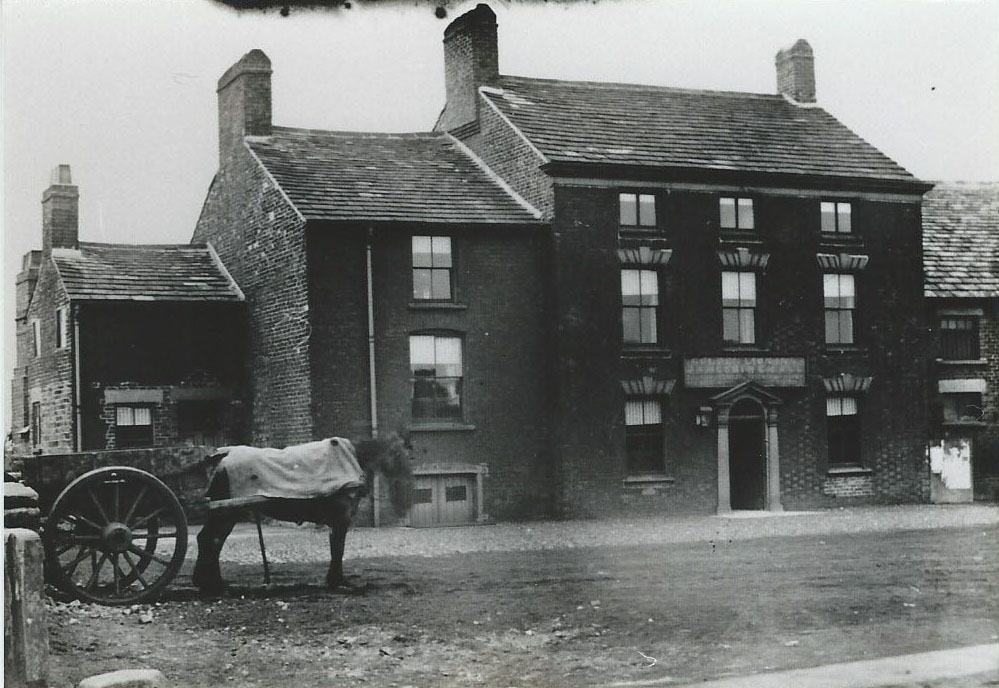
In 1725 the Earl of Derby purchased from Robert Molyneux of Mossborough the freehold of a farm which he leased to the Grounds family who occupied it for the next forty-three years. The next lessee was John Brain who, in 1769, built the grand Georgian building we know today as the Golden Lion Inn. Both John Brain and his wife Susanna had died by 1784 from which time the building was leased for forty years by John Holden and his family as a boarding school for boys. This was followed by a period of domestic use by the Brownbill family until 1840 when Miss Mary Robinson established a boarding school for girls. On the death of Miss Robinson in 1850 her assistant teacher, Miss Hannah Phillips, took on the role of school mistress. It was she who gave the establishment the title of “Alpine House” and remained there until closing the school for lack of pupils about 1871. It so happened that in July 1871 the lease had expired and the property had then reverted back to Lord Derby.
DAME SCHOOL, MOSSBOROUGH ROAD
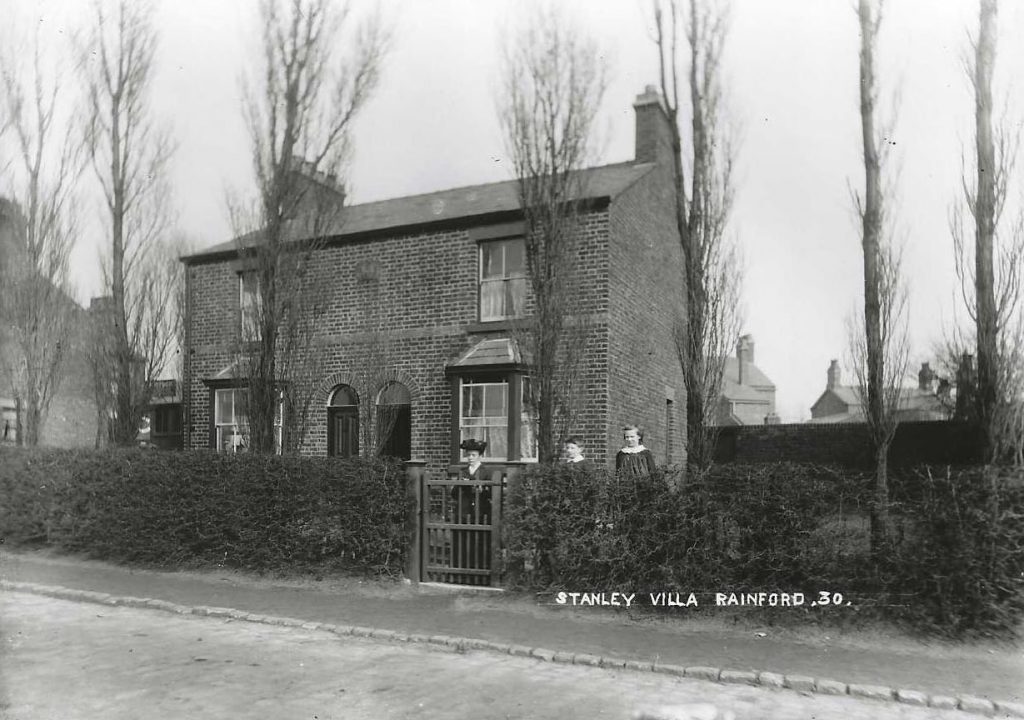
MISS ELLEN FAZAKERLEY PICTURED OUTSIDE HER SCHOOL
This school was in existance from the 1880’s until early 1920’s
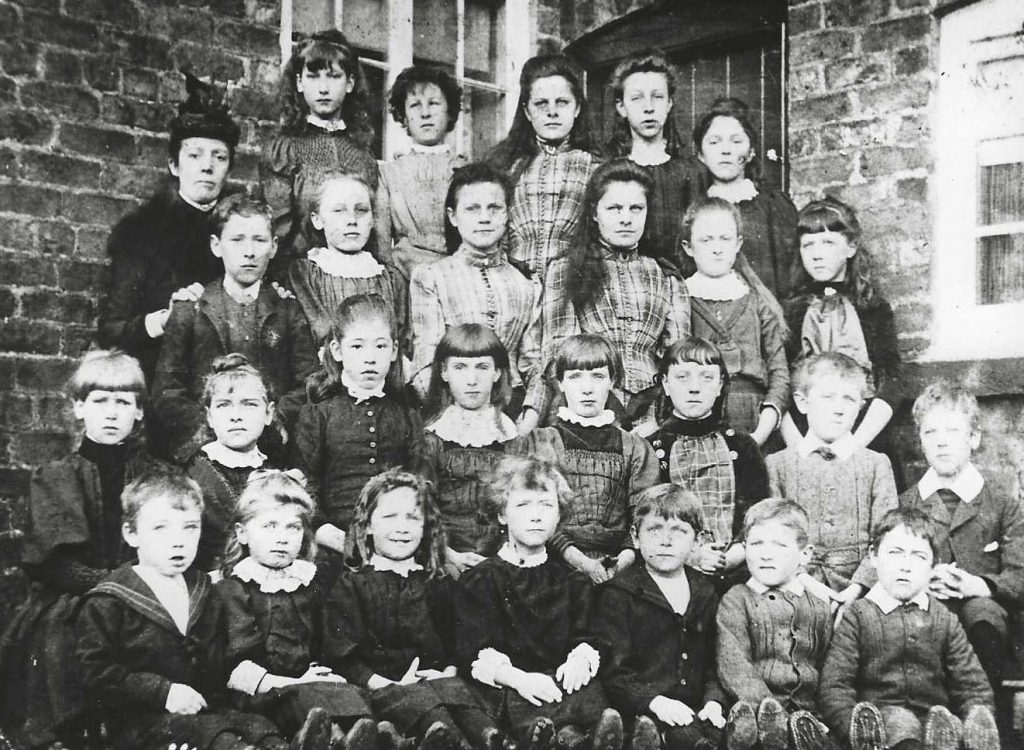
PUPILS PICTURED OUTSIDE THE BACK DOOR OF THE SCHOOL
THE ROW SCHOOL
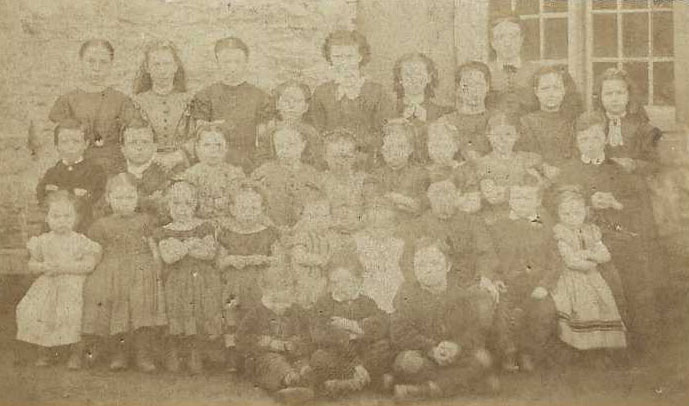
Rainford National School Log Book
Lancashire Record Office Ref. SMRf/1/1
1872 July 3
Admitted several new scholars who previously attended the “Row School” which is now closed.
Sale of School Brow Cottages
Ormskirk Advertiser 6 August 1874
Freehold Cottages in Rainford to be sold by auction by Mr Luke Brighouse at the house of Mr Henry Ball, the Eagle and Child Inn in Rainford on Tuesday the 11th day of August 1874 at 5 o’clock in the afternoon, subject to conditions.
Six freehold cottages with the gardens thereto belonging and a school or meeting house at the back thereof in and fronting to Chapel Lane, Rainford in the occupation of James Swift, Thomas Smith, Richard Birch, Ann Lyon, Esther Snape, —- Glover, as tenants thereof. For further particulars apply to Messrs Wareing & Son, Solicitors, Ormskirk.
The reference to a ‘school or meeting house’ is probably correct as a building at the rear of 126 Church Road is known to have served both purposes at some time and possibly simultaneously.
Before the Methodist Church in Ormskirk Road was built in 1883 a small group of worshipers held their services in this building.